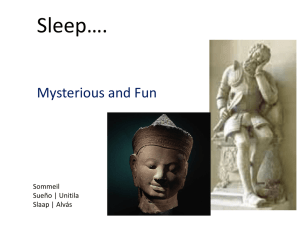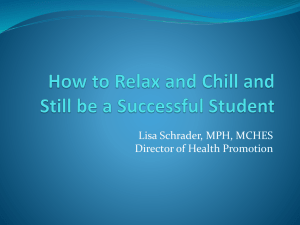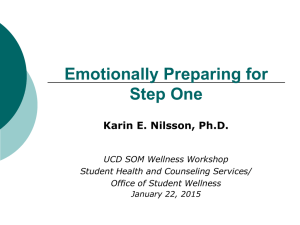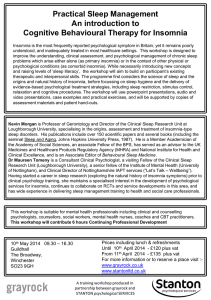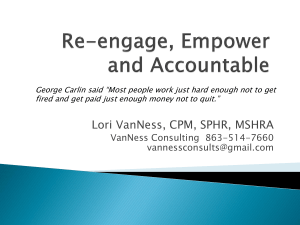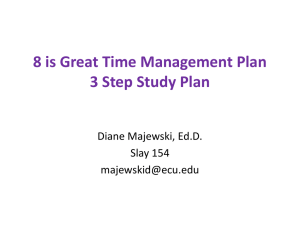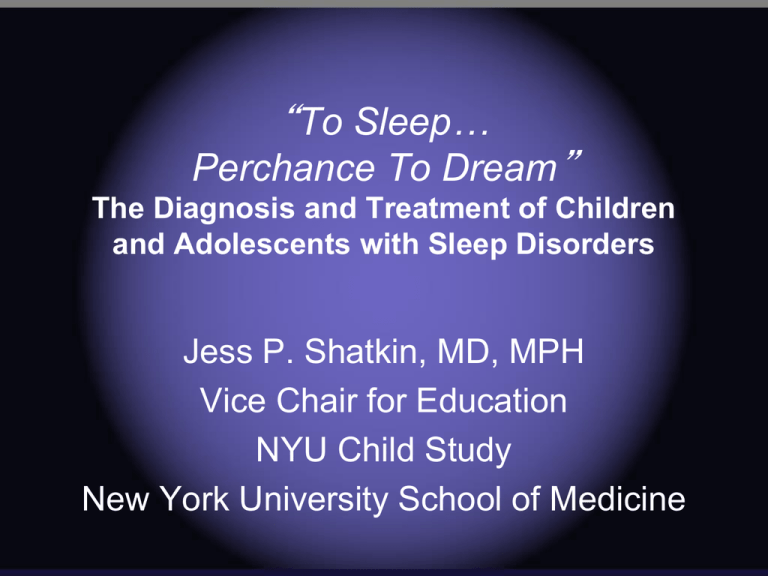
“To Sleep…
Perchance To Dream”
The Diagnosis and Treatment of Children
and Adolescents with Sleep Disorders
Jess P. Shatkin, MD, MPH
Vice Chair for Education
NYU Child Study
New York University School of Medicine
Outline of Presentation
• Review of Normal Sleep Physiology
• Neurocognitive Effects of Sleep Disruption
• Common Sleep Disorders
– Insomnia
– Sleep Disordered Breathing
– Non-REM Parasomnias
– Enuresis
• Sleep in Children with Common Psychiatric
Conditions
Polysomnogram (PSG)
•
•
•
•
•
Electroencephalogram (EEG)
Electromyogram (EMG)
Electrooculogram (EOG)
Vital Signs
Other Physiologic Parameters
Other Methods to Study Sleep
• Ambulatory Techniques
– Edentrace System (monitors pulse, body position, oro-nasal
flow, chest impedance, breathing noises, and pulse oximetry)
– Actigraphy (commonly used, developed in the early 1970s and
has come into increasing use in both research studies and
clinical practice; allows for the study of sleep-wake patterns and
circadian rhythms via the assessment of body movements.
The device is typically worn on the wrist and can easily be
adapted for home use. Reliable and valid for the study of sleep
in normal, healthy populations but less reliable for detecting
disturbed sleep)
• Survey Instruments
– Many exist for detecting problematic sleep in children and
adolescents, including self-report questionnaires (such as the
Sleep Disturbance Scale for Children, the Child Sleep
Questionnaire, and the Child and Family Sleep History
Questionnaire), sleep diaries, and parent report forms.
EEG Sleep Patterns
Awake
Low Voltage, Random, Fast
Drowsy
8-12 Hz, Alpha Waves
Stage 1
3-7 Hz, Theta Waves
Stage 2
12-14 Hz, Sleep Spindles and K-Complexes
Stage 3/4
0.5-2 Hz, Delta Waves, High Voltage, Slow Waves
REM
Low Voltage, Random, Fast with Sawtooth Waves
Important Concepts and Terms
•
•
•
•
•
Sleep Latency
REM Latency
REM Density
REM Rebound
Sleep Onset REM Period
Non-REM Physiological Changes
•
•
•
•
•
•
Reduced physiological activity
Autonomic slowing
Maintain thermoregulation
Episodic, involuntary movements
Few rapid-eye movements
Few penile erections (little vaginal
lubrication)
• Reduced blood flow
REM Physiological Changes
•
•
•
•
Increased physiological activity
Autonomic activation
Altered thermoregulation
Partial or full penile erections (significant
vaginal lubrication)
• Skeletal muscle paralysis
• Rapid-eye movements
The Sleep Cycle
•
•
•
•
Cyclic nature of sleep is reliable
REM periods every 90 – 120 minutes
First REM period is shortest
Most deep sleep (Stage 3 & 4) occurs
early
• Most REM occurs late
Normal Sleep Cycle in Children
Awake
REM
Stage 1
Stage 2
Stage 3
Stage 4
1
2
3
4
Hours of Sleep
5
6
7
Normal Sleep Cycle in Young Adults
Awake
REM
Stage 1
Stage 2
Stage 3
Stage 4
1
2
3
4
Hours of Sleep
5
6
7
Normal Sleep Cycle in the Elderly
Awake
REM
Stage 1
Stage 2
Stage 3
Stage 4
1
2
3
4
Hours of Sleep
5
6
7
Sleep Regulation
• No clear, single center
• Serotonin & Catecholamines (EPI, NOREPI,
DA)
– “REM off” cells
• GABA
• Acetylcholine
– “REM on” cells
•
•
•
•
Suprachiasmatic nucleus
25 hour cycle?
Orexin/hypocretin
Pineal gland (melatonin)
Neuroendocrine Activity in Sleep
•
•
•
•
•
Growth Hormone
Prolactin
Luteinizing Hormone
Cortisol
Thyroid Stimulating Hormone (TSH)
Function of Sleep
•
•
•
•
Restorative/homeostatic
Thermoregulation/energy conservation
Consolidation of learning and memory
Programming of species-specific
behaviors
• “to sleep, perchance to dream, ay
there’s the rub”
– William Shakespeare (Hamlet)
Dreams
Sleep hath its own world, A boundary
between the things misnamed Death and
existence: Sleep hath its own world, And
a wide realm of wild reality, And dreams
in their development have breath, And
tears and tortures, and the touch of joy.
—Lord Byron
Dreams
•
•
•
•
•
REM dreams
Non-REM dreams
Motor paralysis
Rapid-eye movements
Dream content
– Predominantly sad/angry/apprehensive
– Primarily visual
Neurocognitive Effects of Sleep
Disruption: Attention and Memory
• Limited data in children; most info based upon the
effects of sleep disordered breathing (SDB) on
daytime performance
• Sleep restriction in experimental settings results in
inattention and changes in cortical EEG responses
(even after only 1 hour restriction)
• Data are inconsistent on the effects of sleep disruption
on memory performance
• Children suffering from Obstructive Sleep Apnea
(OSA), Periodic Limb Movement Disorder (PLMD),
and Restless Leg Syndrome (RLS) with resulting
sleep fragmentation have been shown to suffer
academic deficits, learning problems, and symptoms
that mirror ADHD
– In the case of OSA, symptoms are generally reversible after
treatment
Neurocognitive Effects of Sleep
Disruption: Psychometric Testing
• Sleep restriction and total sleep
deprivation have been shown to reduce
computational speed, impair verbal
fluency, & decrease creativity and abstract
problem solving ability
• Severe sleep fragmentation (e.g., as seen
in OSA) may result in reduced intelligence
scale scores (IQ)
Neurocognitive Effects of Sleep
Disruption: Academic Achievement
• Children with OSA suffer lower academic
achievement (even when age, race, gender,
SES, and school attended are controlled for)
• Treatment of OSA results in significant
improvement in school performance
• Children who snore loudly and consistently in
early years are at greater risk for academic
delays in later years, suggesting residual
effects on learning even after resolution of
symptoms
– Animal models show increased neuron cell loss in the hippocampus
and PFC in rats exposed to intermittent hypoxia; along with
decreases in special task acquisition and retention and increased
locomotor activity compared to controls
Sleep Disorders in Children
• ~25% of children will suffer some type of sleep
problem at some point during childhood
• Complaints range from bedtime resistance and
anxiety to primary sleep disorders, such as OSA
and narcolepsy
• Research is remarkably consistent, with parents
reporting 50% of preschool children, 30% of
school aged children, and 40% of adolescents as
having sleep difficulties
• Self-report among adolescents reveals 14 – 33%
complaining of frequent or extended nighttime
awakenings, EDS, unrefreshing sleep, early
insomnia, and a subjective need for more sleep
Sudden Infant Death Syndrome
• A worldwide decline in the past decade
• Incidence at roughly 0.77 per 1000 live births in Great Britain; incidence
in the United States has dropped by more than 50% from 1.53 per 1000
live births in 1980 to 0.56 per 1000 live births in 2001
• Still, SIDS accounted for 8% of all infant deaths in the United States in
2002 and ranks as the third leading cause of infant death in the United
States
• The most widely accepted definitions of SIDS require that all other
known possible causes of death be ruled-out by death scene
investigation, review of the clinical history, and autopsy prior to accepting
SIDS as the diagnosis (e.g., intentional or nonintentional injury,
suffocation, etc).
• Efforts aimed at reducing modifiable risk factors for infants, such as
sleeping in a prone position, over-bundling, and secondary smoke
exposure, have reduced the incidence of SIDS by more than 60% in
most parts of the world.
• Other strategies, such as sleeping solitary in a supine position, not
allowing infants to sleep on their sides, and using a pacifier, may
ultimately reduce the incidence still further.
• In the United States, the SIDS rate for African and Native American
infants remains more than twice that of Caucasian infants, reflecting a
long-standing racial disparity.
DSM IV Sleep Disorders:
Dyssomnias
•
•
•
•
•
•
Primary Insomnia
Primary Hypersomnia
Narcolepsy
Breathing Related Sleep Disorder
Circadian Rhythm Sleep Disorder
Dyssomnia NOS
Primary Insomnia in the General Population
• Early and middle insomnia
• PSG studies are negative
• Sub-clinical symptoms of psychiatric illness
often present
• More common w/increasing age and in women
• Prevalence: 1 – 10% in general population; up
to 25% in elderly
• Generally sudden onset w/continuation due to
negative conditioning and development of
maladaptive sleep patterns
Pediatric Insomnia
• No clear definition has existed until this
year: “Repeated difficulty with sleep
initiation, duration, consolidation, or quality
that occurs despite age-appropriate time
and opportunity for sleep and results in
daytime functional impairment for the child
and/or family.”
– International Classification of Sleep Disorders-2
Pediatric Insomnia (2)
• Prevalence estimated at 1 – 6 % in general
pediatric population but considerably higher
amongst those children with neurodevelopmental delay and chronic med/psych
conditions
• A recent study of 46 children (5-16 y/o) found
that 50% of the those presenting to a
pediatric sleep center for insomnia had a
preexisting psych diagnosis and the
remaining 50% had elevated psych
impairment scores on psychometric
measures & diagnostic interview (Ivanenko et al, 2004)
Behavioral Insomnia
• A recently introduced diagnostic category to
emphasize the sleep difficulties resulting
from inadequate limit setting or sleep
associations:
– Rocking
– Watching TV
– Falling asleep every night in the parent’s bed
• The child is unable to fall asleep in the
absence of these conditions at both bedtime
and following nocturnal awakenings
Case #1: Insomnia
• James is a 15 year-old male with a childhood
history of moderate separation anxiety for which
he never received treatment. He has a history of
mild/moderate sleep disruption (primarily early and
occasional middle insomnia), but over the past 6
weeks he has suffered increasing insomnia
concurrent with an increase in school stressors.
He presents to you with complaints of a two hour
sleep onset latency 4x/week and nightly nocturnal
awakenings with difficulty falling back to sleep.
• How do you proceed?
Treatment of Insomnia: Sleep
Hygiene
• Identify the cause or other Axis I disorder (if
possible) and treat
• Set a sleep/wake schedule
• Exercise daily but not at night
• Avoid caffeine, cigarettes, alcohol, and drugs
• Invent a relaxing bedtime ritual (e.g., bathing,
reading, watching TV, etc.)
• Use the bed for sleeping or sex, nothing else
• Wake up to the sun, exposing yourself to
morning sunshine
• Adjust the room temperature as desired
Treatment of Insomnia (2): Medication
• No FDA approved treatments
• Sedatives are short-term solutions
• A shorter half-life is typically preferred
– Sedating antihistamines (diphenhydramine,
hydroxyzine, cyproheptadine)
– Alpha-2 agonists (clonidine, guanfacine)
– Sedating antidepressants (Trazodone, Serzone,
Remeron, TCAs,)
– Benzodiazepines and similar agents (Sonata, Ambien,
Lunesta, Rozarem) preferred over barbiturates
• Tolerance to somnolent effects of Benzos develops in about 4
weeks (not anxiolytic effects)
– HM/DS: Melatonin, Kava, Valerian, L-tryptophan,
chamomile, passion flower, lavender, etc
Sleep Disordered Breathing (SDB)
• Primary Snoring
– regular snoring without changes in sleep
architecture, alveolar ventilation, or
oxygenation
• Upper Airway Resistance Syndrome
– Similar to OSA but UARS does not result in
blood oxygen desaturations
• Obstructive Sleep Apnea
– Results in blood oxygen desaturations
SDB: Epidemiology
• Primary Snoring
*Prevalence = 7 – 12%
• Upper Airway Resistance Syndrome
*Estimates difficult to ascertain
• Obstructive Sleep Apnea
*Prevalence = 1 – 2%
SDB Clinical Presentation
• Parents complain of:
– Snoring
– Frequent awakenings
– Excessive Daytime Sedation
– Poor academic performance
– Irritability
– Poor executive function
– Inattention/general cognitive impairment
SDB Evaluation and Treatment
• Labs show:
– A reduction in airflow and Hgb saturation
– Increased total Hgb
– Cardiac arrhythmias (sinus arrhythmias, PVCs,
AV block, sinus arrest)
– Stage 1 >> 3,4 & REM
• Physical Examination shows:
– Adenotonsillar enlargement
– Pectus excavatum & rib flaring
– More commonly in adults: obesity, >17” neck
size, HTN, cor pulmonale
Treatment of Sleep Apnea
• Weight loss
• Sleep on sides (and stomach)
• CPAP (Continuous Positive Airway
Pressure) prevents obstruction by softtissue and keeps airway open
• Surgical intervention (e.g., enlarged
tonsils, deviated septum)
• Avoid sedatives (which can prevent
reawakening to breathe)
DSM IV Sleep Disorders:
Non-REM Parasomnias
•
•
•
•
•
Somnambulism
Sleep/Night Terrors
Somniloquy
Enuresis
Sleep Related Involuntary Movement
Disorders
– PLMD
– Body Rocking
– Bruxism
Enuresis: Epidemiology & Diagnosis
• Occurs in approximately 30% of 4 y/o, 10%
of 6 y/o, 5% of 10 y/o, 3% of 12 y/o, and 1%
of those 15 y/o and over
• Although not satisfying DSM-IV criteria for
diagnosis, 10 – 20% of 5 y/o continue to
have a least one episode of nocturnal
enuresis/month
• DSM-IV requires:
– Frequency at least 2x/week for at least 3 months
– age at least 5 years
Enuresis: Etiology
• Primary enuresis (never consistently dry)
– Multifactorial etiology w/difficulties in: bladder
musculature stability, CNS arousability,
pontine reflex function, internal sphincter tone,
functional bladder capacity, nocturnal urine
production, & maturational delay in ADH
secretion
• Secondary enuresis (previously dry for 6
mo)
– UTI, diabetes mellitus, psychological factors
Associated Features
• Nocturnal enuresis is associated with poor
self-image, diminished achievement in
school, and an increase in the time spent
by families compensating, both financially
and personally, for the symptoms.
• Risk factors (twice as common in
boys>girls, family history, lower SES,
black race)
Case #2: Enuresis
• Ryan is a 10 y/o male with a history of mild MR,
ADHD (CT), and severe ODD with a rule-out of
Bipolar D/O NOS. He also suffers nightly
enuresis. Current medications include Concerta
54 mg qAM and Risperdal 0.25 mg BID. His
parents have tried numerous behavioral
interventions with no success. Ryan has
previously been treated with desmopressin
acetate to 4 mg hs and imipramine to 50 mg hs.
• What questions do you have?
• How would you proceed?
Enuresis: Treatment (1)
• Full history (e.g., nature of “behavioral”
treatments tried, how medications were
used)
• Psycho-education for family and patient
• Discontinue all caffeine and EtOH
• Restrict late night fluid intake
• Afternoon nap (to decrease Stage III/IV)
• Brief awakening for toileting at midnight
Enuresis: Treatment (2)
• Behavioral Treatments:
– Bedwetting alarm (highest cure rate, lowest
relapse rate)
– Bladder training to increase capacity
– Reward systems
– Cognitive & motivational therapy
– Pelvic floor muscle training
– Biofeedback
Enuresis: Treatment (3)
• Medications:
– Desmopressin acetate (DDAVP)
• Intranasal (10 – 60 mcg) vs. oral (0.1 – 0.6 mg)
– Imipramine or amitriptylene
• 25 – 50 mg
– Anticholinergic (antispasmodic) agents
• Oxybutinin (Ditropan) 2.5 – 5 mg or tolterodine
(Detrol) 0.5 – 1 mg
– Combination treatment
• DDAVP + oxybutinin or DDAVP + TCA
– Atomoxetine (Strattera)
Non-REM Sleep Disorders and
Unconscious Actions
• Doctor: “You see, her eyes are open.”
• Lady-in-Waiting: “Ay, but their sense are
shut.”
– William Shakespeare (The Tragedy of
MacBeth)
Non-REM Sleep Parasomnias:
Shared Features
•
•
•
•
•
•
•
•
1 – 30 minutes
Retrograde amnesia
Family/personal history
High potential for injury to self and others
Occur during slow-wave sleep
More common in childhood
Attempts to awaken are fruitless
Psychopathology rare in children
Non-REM Sleep Parasomnias:
Precipitating Factors
•
•
•
•
•
Dyssomnia
Sleep deprivation
Medications
Magnesium deficiency
Hormonal factors
Sleep Terrors
• Infrequent occurrence
– Prevalence 3–6.5% in children, 1–2.6% in
adults
•
•
•
•
Autonomic activation
30 seconds – 3 minutes
Complete amnesia
Gender preference
– Males typically in childhood
– Females possibly more common in adulthood
Sleepwalking
• Common occurrence
– Prevalence 6-17% in children; lifetime
incidence 40%
– Prevalence 2.5% in adults
•
•
•
•
•
Generally docile
Often coupled with enuresis
No consistent gender differences
Complete amnesia
May engage in complex behaviors
Confusional Arousal
• Epidemiology unclear
– 4% incidence in Stockholm study
– No gender differences noted
• Hallmarks include irrational acts, poor
judgment, incoherence, and disorientation
• Autonomic arousal
• Complete amnesia
• Premeditated acts believed impossible
Case #3: Non-REM Parasomnia vs.
Suicide Attempt
• Tracy is a well adjusted 12 y/o girl from an intact
and loving family with no psychiatric history.
One summer’s evening, an hour after going to
bed, she was awoken with a severe sore throat.
She stumbled to the mirror to find her throat cut
wide open to her trachea with two 5” horizontal
lacerations extending the breadth of her neck. A
bloodied box cutter was found at her bedside;
she had no memory of the event.
• How would you make a diagnosis?
• How would you treat this case?
Treatment of Non-REM Parasomnias:
Psychosocial Interventions
•
•
•
•
Repeat of a violent episode is rare
Family/patient education
Avoid possible precipitants
Avoid sleep disruptions
– Loud noises, limit evening oral fluid intake
• Safeguard the home
– Movement sensors, locks on windows, remove
potentially lethal objects, etc.
• Enforce afternoon naps with Sleep Terrors
Treatment of Non-REM Parasomnias:
Medication
• Benzodiazepines with long half-lives
– Clonazepam, Diazepam
• Tricyclic antidepressants
– SSRIs and Trazodone
• Barbiturates
– possible use in REM sleep disorders
DSM IV Sleep Disorders:
REM Parasomnias
• REM Sleep Behavior Disorder
• Sleep Paralysis
• Nightmare Disorder
Sleep in Children with Common
Psychiatric Conditions
•
•
•
•
ADHD
Pervasive Developmental Delays
Mood Disorders
Anxiety Disorders
ADHD: Epidemiology
• All variety of sleep disorders are more
common amongst children with ADHD than
healthy controls, controls with other psych
illness, and health siblings by 5x
• The DSM-III considered excessive
movements during sleep to be a criterion for
hyperactivity in children
• It is estimated that up to 25% of children
with severe sleep problems in infancy will
later qualify for a diagnosis of ADHD
ADHD: Clinical Presentation
• Greater variation in sleep onset time, wake
time, and sleep duration
• Significantly more bedtime struggles with
parents
• Habitual snoring is 3x more common in
children with ADHD
• Greater frequency of PLMD and SDB have
also been frequently reported
ADHD: Treatment Recommendations
•
•
•
•
Enforce sleep hygiene
Lower the dose or change the stimulant
Change to a shorter acting preparation
Add a low dose of stimulant (if insomnia
appears due to hyperactive “rebound”)
• Change to an entirely novel agent (e.g.,
atomoxetine)
• Use adjunctive agents: antihistamines,
clonidine, sedating antidepressants, &
melatonin
PDD: Epidemiology
• 44 – 88% of children with frank autism are
reported to suffer sleep difficulties as are 44
– 86% of children with Autism Spectrum
Disorders
• Younger children and those with more
severe cognitive delay/disability tend to
demonstrate increased problems
• Sleep problems are often long-standing; a
recent study of adults with Asperger’s
demonstrated that 90% complain of
“frequent” insomnia
PDD: Clinical Presentation
• Most frequently reported problems are
difficulty falling asleep, frequent awakenings
with difficulty returning to sleep, early
morning awakening, irregular sleep/wake
patterns, shortened duration of sleep,
dyssomnias & parasomnias
• Etiology may have to do with failure to
recognize environmental and social cues,
poorly developed circadian rhythms (b/c of
social deficits), altered melatonin
production, and abnormalities in the HPA
axis
PDD: Treatment
• Sleep hygiene & behavioral treatments
• Chronotherapy +/- light therapy for those
with circadian rhythm problems or phase
shifting
• Unstudied medications: antihistamines,
sedating antidepressants, alpha-2 agonists,
benzodiazepines, antipsychotics
• Melatonin
– Sedative
– Synchronizing sleep to environment
Mood Disorders: Epidemiology
• 2/3 of depressed children have early &
middle insomnia and 50% report late
insomnia
• Up to 88% of depressed adolescents report
sleep disturbances (primarily insomnia) with
up to 25% of these reporting hypersomnia
– Approximately 10% experience continual
insomnia after the depression has lifted
• One study of bipolar children found 40%
had a dramatically reduced need for sleep
(vs. controls and those with ADHD)
Mood Disorders: Clinical Presentation
• Children may demonstrate bedtime
resistance, bedtime anxiety, early & middle
insomnia, desire to co-sleep, enuresis,
nightmares, sleep-walking, early morning
awakening, and EDS
• Adolescents report difficulties with early and
middle insomnia (w/extended awakenings),
EDS, unrefreshing sleep, and up to 50%
report early morning awakening
• Sleep difficulties in adolescents appear to be
chronic and affect girls more than boys
Mood Disorders: Clinical Presentation (2)
• Adolescents who report sleep problems are
much more likely to report symptoms of
depression, anxiety, poor self-esteem,
lethargy, irritability, and emotional lability
• Adolescents who report sleep problems are
also much more likely to consume caffeine,
nicotine, and alcohol
• Thus, sleep problems should be viewed as a
potentially easy marker for adolescents at
risk of developing some sort of
psychopathology
Sleep in Adults with Depression
• Reduced REM latency
• Increased percentage of REM
• REM distribution shifts to earlier in sleep
cycle
• Reduction in REM sleep useful in
treatment
• REM is preferentially selected in sleep
deprived and/or depressed state
Mood Disorders: Treatment
• Identify and treat the primary Axis I disorder
• Sleep hygiene and medications as indicated
• No clear data on whether or not to treat the
symptom of insomnia independent from the
mood disorder
– Borrowing from adult studies, this may make
sense for pediatric bipolar disorder
Anxiety Disorders: Epidemiology
• Anxiety and sleep are intimately tied in
childhood
• Sleep problems by age 4 are correlated with
later onset depression and anxiety by 15
• Nighttime fears are common (up to 75%
report)
• Sleep problems typically follow for those
children with DSM-IV anxiety disorders
(PTSD, OCD, school refusal, etc.)
Anxiety Disorders: Clinical
Presentation
• Nighttime fears commonly take the form of
animals, fictitious characters (e.g., witches
& monsters), being kidnapped, or being
teased by peers
• Anxiety is believed to predispose children to
parasomnias and nightmares
• Occasional nightmares occur in 80% of
children
– 15% report frequent nightmares (>1/month)
– 69% of children report that the content of their
nightmares is influenced by frightening material
viewed on TV or at the movies
Anxiety Disorders: Treatment
• Identify and treat the primary Axis I disorder
• Sleep hygiene and medications as indicated
• No clear data on whether or not to treat the
symptom of insomnia independent from the
anxiety disorder


